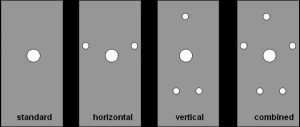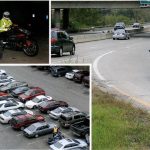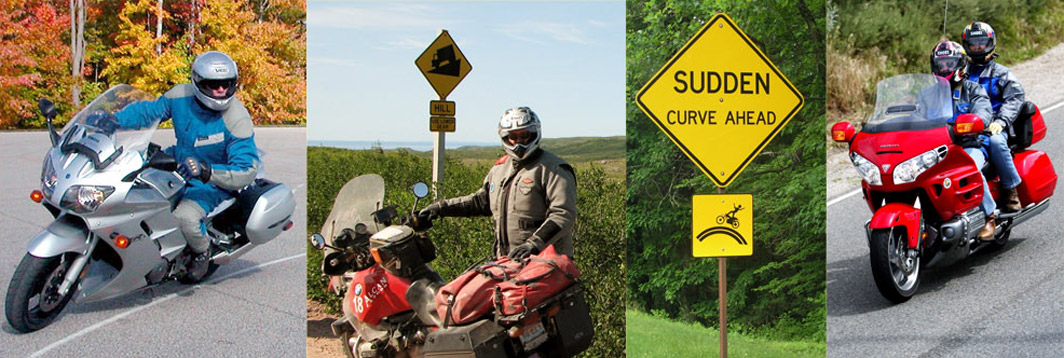Conspicuity (HighViz)

This section contains research regarding motorcycle/motorcyclist conspicuity (con-spik-CUE-i-tee). For information and tips on how you can make yourself and your motorcycle more conspicuous visit the Gear – HighViz pages.
Much of the information in this introduction is taken from PTW crashes and the role of perception (Christoforou, 2015).
Low or limited motorcycle and motorcycle rider conspicuity has been long recognized as an important motorcyclist crash contributory factor. Crash investigations from many countries indicate that between half and three-quarters of all motorcyclist crashes involve collision with another vehicle. In many of these collisions the other vehicle violated the motorcyclists’ right-of-way (ROW). Most of these ROW violation crashes involving motorcyclists are attributed to perception errors on the part of the other vehicle driver. The driver of the other vehicle violated the motorcyclists ROW because they ‘looked but failed to see’ (LBFS). LBFS crashes happen when the car driver pulls into the path of an oncoming motorcyclist and claims not to have seen him/her approaching.
One often discussed reason for LBFS ROW violation caused crashes is that motorcycles/riders are less conspicuous than other road users. The theory then is the frequency of these types of crashes could be reduced if motorcycles and riders were made more conspicuous. A lot of research has been undertaken since the mid-1970’s on this ‘motorcycle conspicuity hypothesis.’
The word conspicuity is often just considered a fancy term for visibility or notice-ability meaning the ability of an object to draw attention to itself, even if nobody’s actively searching for it. However, as the abundance of research available here shows, the issue of motorcycle and motorcyclist conspicuity is a highly complex matter. Conspicuity can be examined from at least two different perspectives.
First is the perspective we usually associate with the term. This perspective refers to the extent that an object (in our case motorcycle and rider) can be distinguished from its environment because of its characteristics (size, brightness, color and so on). It is the objects ability to attract visual attention and to be precisely located because of its physical property. This is called sensory conspicuity and this perspective leads to measures like extra lighting and high-viz riding gear.
Second is cognitive conspicuity. This is from the perspective of the observer. Cognitive conspicuity depends on the distinction of an object based on the observer’s experiences and interests. It is linked to the fact that an observer’s focus of attention is strongly influenced by his/her expectation, objectives and knowledge. Visual/cognitive phenomena such as inattentional blindness and change blindness are important factors that are associated with the observer.
Motorcycle and rider conspicuity are, therefore, not just connected to the rider and motorcycle but most importantly to the observer and both are connected to the ever changing environment for both the rider and observer. Color, light and contrast are the primary components of conspicuity. Here is a link to a blog article by Clearwater Lights that explains these three components. SMARTER has no connections with Clearwater Lights.
While the overall evidence certainly does indicate there is a benefit to riders who make themselves and their motorcycle more conspicuous (high-viz), there remain many unanswered questions.
Christoforou, Zoi & Yannis, George & John, G & Peter, S. (2015). PTW crashes and the role of perception. Increasing Motorcycle Conspicuity: Design and Assessment of Interventions to Enhance Rider Safety. 3-20.
Conspicuity Research Studies
2022 – “Effect of Motorcycle Lighting Configurations on Drivers’ Perceptions of Closing”
The aims of this research were to better understand how drivers perceive an approaching set of motorcycle headlights during nighttime driving. The authors conclude an alternative motorcycle headlight configuration that accentuated the full extent of a motorcycle’s size resulted in drivers perceiving closing sooner than other motorcycle headlight configurations but not sooner compared to a car.
2021 – “Conspicuity – Articles by Kevin Williams”
This document provides multiple links to the work of Kevin Williams (author of the Science of being Seen) on subject of the motorcycle/motorcyclist conspicuity. While the overall evidence certainly indicates there is a benefit to riders who make themselves and their motorcycle more conspicuous (high-viz), there remain many unanswered questions. In this series of six articles, Kevin succinctly summaries the research.
2019 – “Motorcyclists’ Attitudes on Using High-Visibility Gear to Improve Conspicuity: Findings From a Focus Group Study.”
Prior research on multi-vehicle motorcycle crashes suggests that difficulty detecting motorcycles is a relevant factor. A potential countermeasure to this phenomenon is for a motorcycle rider to wear high-visibility gear, especially at night or in low-light conditions. Yet, many riders do not wear high-visibility gear. This report describes a study that explored why riders choose, or do not choose, to wear high-visibility gear.
2018 – “Why Do Drivers Pull Out in Front of Motorcyclists?”
This is an excellent current comprehensive review of the literature regarding the title topic. The review is written March 5, 2018 by Nathan Rose, Director and Principal of Kineticorp, LLC., (303)733-1888, (720)839-1995, www.nathanarose.com/blog, http://kineticorp.com). Note: SMARTER is providing this contact information as a thank you for the permission to post this article and no endorsement of the LLC or its staff should be implied.
2018 – “Conspicuity Research Summary”
A ten point summary of the conspicuity research compiled by SMARTER.
2016 – “The Role of Lane Position in Right-of-Way Violation Collisions Involving Motorcycles”
This is the authors’ Master Degree thesis. Low motorcycle conspicuity is believed by many to be causally involved in motorcycle collisions that involve another driver. Because the hypothesis that motorcycles lack conspicuity in traffic is so intuitively appealing and so pervasive, it has never been tested. This work provides an argument against the notion that right-of-way-violation colli sions are due to poor motorcycle detection resulting from their low conspicuity and proposes an alternate hypothesis: These collisions seem related to failures in motion-perception which are partially caused by the motorcycle’s approach path in a left-of-lane position which, ironically, is partly intended to increase the motorcycle’s conspicuity. See also, 2014 - “Motorcyclist’s Lane position as a Factor in Right-of-Way Violation Collisions: A Driving Simulator Study”
sions are due to poor motorcycle detection resulting from their low conspicuity and proposes an alternate hypothesis: These collisions seem related to failures in motion-perception which are partially caused by the motorcycle’s approach path in a left-of-lane position which, ironically, is partly intended to increase the motorcycle’s conspicuity. See also, 2014 - “Motorcyclist’s Lane position as a Factor in Right-of-Way Violation Collisions: A Driving Simulator Study”
2016 – “Role of Sensory and Cognitive Conspicuity in the Prevention of Collisions Between Motorcycles and Trucks at T-intersections”
Abstract. There is a considerable difference in height between motorcycles and trucks. Hence, the authors anticipated that the effects of motorcycle conspicuity treatments would be different for truck drivers. Therefore, the study aims to evaluate the effects of motorcycle conspicuity treatments on the identification and detection of motorcycles by truck drivers.
2016 – “Improving Motorcycle Conspicuity through Innovative Headlight Configurations”
The aim of this study is to investigate the effect of different headlight configurations on motorcycle detectability when the motorcycle is in visual competition with cars. The results revealed a beneficial effect of standard yellow configuration and the vertical yellow configuration on motorcycle detectability. However, this effect was modulated by the car-DRL environment. Findings and practical recommendations are discussed with regard to possible applications for motorcycles.
2015 – “Problems of Sensory and Cognitive Conspicuity of Motorcyclists at Junctions: A Car to Motorcycle Comparison of Visual Search and Give-way Intentions by Car Drivers from Two Angles of Approach”
It is often assumed that motorcyclists have a relatively higher chance of falling victim to car driver right-of-way violations than cars at junctions. Various studies have pointed out this is particularly the case due to the motorcyclist’s poorer sensory- and cognitive conspicuity. The main goal of this study was to examine differences in visual search and intentions to give way by car drivers, when motorcycles and cars approached two prior selected, four-legged non-regulated junctions.
2015 – “Powered-Two-Wheeler (PTW) Crashes and the Role of Perception”
This is a chapter of a larger report which examines the main determinants of riders’ accident risk that are related to conspicuity issues. It is an excellent overview of the issue. The authors perform a literature review to explore the role of conspicuity in PTW crash occurrences and organize PTW conspicuity risk factors in (i) human-related, (ii) vehicle-related, and (iii) road environment-related factors.

2015 – “Role of Motorcycle Running Lights in Reducing Motorcycle Crashes during Daytime; A Review of the Current Literature”
This paper highlights previous studies on the implementation of motorcycle DRLs, focusing on the efficacy of the DRLs to improve motorcycle conspicuity. All literature, supporting that operating headlights during daytime appears to be an influential and effective approach to reduce rate of collision by improving motorcycle’s conspicuity in traffic.
2015 – “Increasing Motorcycle Conspicuity: Design and Assessment of Interventions to Enhance Rider Safety”
This 258 page book contains extensive references and an overview of recent research. The book outlines the factors that contribute to PTW (Powered Two-Wheelers) visibility and detection by car drivers, and presents case studies to illustrate how the various methods can be used to explore the contribution of these factors. The case studies collected within the volume cover phases of the design of conspicuity treatments and provide a broad spectrum of empirical strategies for assessing the interventions. The book is most directly relevant to researchers and applied scientists from the fields of traffic/transportation psychology and human factors, as well as to practitioners from the traffic safety sector. Available from Amazon, Google Books, etc.
2015 – “Improving Car Drivers’ Perception of Motorcycles: Innovative Headlight Design as a Short-term Solution to Mitigate Accidents”
In order to reduce motorcycle accidents, and especially to improve motorcycle perceptibility (both detection and speed perception) by other vehicle drivers, ITS based on vehicle-to vehicle communication will probably provide effective long-term solutions (>15 years). But until then, other solutions have to be found and could quite easily be implemented, by considering innovative headlight configurations for motorcycles.
2014 – “Motorcyclist’s Lane Position as a Factor in Right-of-Way Violation Collisions: A Driving Simulator Study”
A driver turning left and failing to notice an oncoming motorcyclist until too late is the most common cause of motorcycle collisions. Consequently, much previous research has focused on motorcycle properties, such as size, shape, and color to explain its inconspicuousness. However, collision statistics remain largely unchanged, suggesting that the issue may not be related solely to the motorcycle’s static properties. In this study, the authors examined a different characteristic of the motorcycle, namely its trajectory of approach. Results show that drivers are more likely to turn in front of an oncoming motorcycle when the motorcyclist is traveling in the left-of-lane position than when it travels in the right-of-lane position. See also 2016 - The Role of Lane Position in Right-of-Way Violation Collisions Involving Motorcycles which is the Master of Arts thesis of the lead author.
2014 – “Influence of Front Light Configuration on the Visual Conspicuity of Motorcycles”
Three conspicuity enhancements designed to improve motorcycle detectability in a car-DRL environment were evaluated in comparison to the standard configuration. The results revealed better motorcycle-detection performance for both the yellow headlight and the helmet configuration than for the standard configuration.
performance for both the yellow headlight and the helmet configuration than for the standard configuration.
2014 – “A Different Perspective on Conspicuity Related Motorcycle Crashes”
The concept of ‘looked-but-failed-to-see’ crashes is a recurring item. On the other hand, it is not entirely unexpected that motorcycles have many conflicts with cars; there simply are so many cars on the road. This paper tries to unravel whether – acknowledging the differences in exposure – car drivers indeed fail to yield for motorcycles more often than for other cars. There is only one priority situation where motorcycles seem to be at a disadvantage compared to cars. This is when a car makes a left turn, and fails to give priority to an oncoming motorcycle.
2013 – “Improving Car Drivers’ Perception of Motorcyclists through Innovative Headlight Configurations”
 The findings of the present study indicate that innovative motorcycle headlight ergonomics can improve motorcyclist safety by increasing the gaps accepted by automobile drivers when they turn left in front of a motorcycle. Among the headlight configurations tested, only light arrangements that accentuated the vertical dimension of the motorcycle/motorcyclist outline provided substantial improvements as compared to motorcycles equipped with only standard headlights.
The findings of the present study indicate that innovative motorcycle headlight ergonomics can improve motorcyclist safety by increasing the gaps accepted by automobile drivers when they turn left in front of a motorcycle. Among the headlight configurations tested, only light arrangements that accentuated the vertical dimension of the motorcycle/motorcyclist outline provided substantial improvements as compared to motorcycles equipped with only standard headlights.
2013 – “Motorcycle: Crash Trends, Conspicuity and Interventions”
For this study, motorcycle crashes in North Dakota are examined using crash data from 2002 to 2012. Additional information regarding motorcycle conspicuity and rider training and education is presented as a basis for efforts to guide crash prevention.
2012 – “Issues in Motorcycle Sensory and Cognitive Conspicuity”
Abstract. This report evaluates the impact of motorcycle low-beam headlights and riding experience on drivers' decisions to turn across the path of a motorcycle. The research provides support for the use of low-beam headlights and riding experience as tools through which to augment the sensory and cognitive conspicuity of motorcycles, respectively.
2012 – “Increasing Motorcycles Attention and Search Conspicuity by Using Alternating-Blinking Lights System (ABLS)”
Poor conspicuity of Powered Two-Wheelers (PTW) is one of the main factors contributing to their involvement in accidents. The current study examined the influence of different rider's outfits on PTWs’ detectability, and evaluated the potential of a unique Alternating-Blinking Lights System (ABLS) to increase the rider's conspicuity.
2012 – “Exploring Factors Distinguishing Car-versus-Car from Car-versus Motorcycle in Intersection Crashes”
Abstract. This research examines car versus car (CVC) and car versus motorcycle CVM) crashes in New Zealand 2004 to 2009 police reports. The analyses show that CVM-type crashes are not easily distinguished from CVC type crashes. The two crash types are similar, contrary to overseas recent findings with four exceptions: CVM-type crashes occur more often than expected in urban speed zones, between the times of 4–7 pm, and at uncontrolled intersections.
2012 – “Attention and Search Conspicuity as a Function of their Visual Context”
Over the years, Powered-Two-Wheelers’ (PTWs’) numbers of accidents have increased dramatically and have accounted for a high percentage of the total traffic fatalities. The majority of those accidents occur in daylight, clear weather, and at light to moderate traffic conditions. The current study included two experiments. The first experiment evaluated the influence of PTW attention conspicuity on the ability of un-alerted viewers to detect it, whereas the second experiment evaluated the PTWs search conspicuity to alerted viewers. The independent variables in both experiments included driving scenarios (urban and inter-urban), PTW rider’s outfit (black, white, and reflective) and PTW distance from the viewer.
2012 – “Motorcycle Conspicuity: What Factors have the Most Impact?”
The objective of this project was to determine the effect of headlight configuration (daytime running lights, high beam, modulating) and rider color (bright yellow, blue denim, and black torso and helmet) on the conspicuity of a motorcycle to a driver of a passenger vehicle in a simulated environment.
2012 – “Literature Review of Interventions to Improve the Conspicuity of Motorcyclists and Help Avoid ‘looked but failed to see’ Accidents”
New Zealand. Studies that have sought to examine the effectiveness of interventions to increase the conspicuity of motorcycles or motorcyclists (in lab studies, or in real world settings) were reviewed using a systematic approach to ensure that only relevant studies were included. In addition, studies were graded for scientific quality to ensure that any conclusions drawn were based on the best available evidence. Includes more than 60 references.
2012 – “Hi Viz: The Way to G(l)o? An Investigation of Motorcycle Rider Use of and Attitudes Towards High Visibility Gear”
This study was conducted in New Zealand. There is some evidence that shows that High Visibility Gear (HVG) can improve motorcyclists’ safety, but the use of HVG is currently low. The study found that the most important barriers to wearing HVG that motorcyclists identified were cost, image and practicality.
2011 – “Differences in Motorcycle Conspicuity-related Factors and Motorcycle Crash Severity in Daylight and Dark Conditions”
Using motorcycle crash data for Iowa from 2001 to 2008, this paper identified those motorcycle-conspicuity factors that could potentially relate to a collision between a motorcycle and another vehicle. Motorcycle conspicuity-related factors that were examined included: light conditions, helmet use, manner of crash, and motorcycle and “non-motorcycle” driver actions.
2011 – “Car Drivers’ Attitudes and Visual Skills in Relation to Motorcyclists”
The analysis of collision data suggests that some of the most common motorcyclist collisions involve errors on behalf of other road users, for example car drivers who fail to give way to an approaching motorcycle at a T-junction. Following such accidents, car drivers often claim that they looked, but did not see the approaching motorcycle. This project involved three studies to explore these issues further.
2011 – “Motorcycle Right-of-Way Accidents: A literature review”
The most typical automobile–motorcycle collision take places when an automobile maneuvers into the path of an approaching motorcycle by violating the motorcycle's right of way (ROW). This paper provides a comprehensive review of past research that examined motorcycle ROW accidents.
2011 – “Evaluation of Motorcycle Conspicuity in a Car DRL Environment”
The advantage of the use of DRL exclusively by motorcycles  is presently becoming lost by the increasing use of DRLs on cars. The present experiment aimed at evaluating the effects of car DRLs on motorcycle perception in a situation that specifically brought attentional conspicuity to bear. Car DRLs noticeably hampered motorcycle perception compared to conditions where car lights were not on. Several means of improving motorcycle conspicuity in car DRL environments are discussed.
is presently becoming lost by the increasing use of DRLs on cars. The present experiment aimed at evaluating the effects of car DRLs on motorcycle perception in a situation that specifically brought attentional conspicuity to bear. Car DRLs noticeably hampered motorcycle perception compared to conditions where car lights were not on. Several means of improving motorcycle conspicuity in car DRL environments are discussed.
2011 – “Errors in Judging the Approach Rate of Motorcycles in Nighttime Conditions and the Effect of an Improved Lighting Configuration”
This paper explores drivers’ abilities to make judgments of motorcycles and car approach speeds in nighttime driving conditions, when only the headlights are visible, as well as the effectiveness of a tri-headlight configuration on the accuracy of motorcycle speed judgments. The addition of a tri-headlight formation on a standard motorcycle frame significantly improved judgments.
2011 – “Decisions about Objects in Real-world Scenes are Influenced by Visual Saliency Before and During their Inspection”
The saliency of a critical vehicle was varied in the present task, as was the type of vehicle and the preferred vehicle of the viewer. Decisions were influenced by saliency, with more risky decisions when low saliency motorcycles were present. Given that the vehicles were invariably inspected, this may relate to the high incidence of ‘‘looked-but-failed-to-see’’ crashes involving motorcycles and to prevalence effects in visual search.
2011 – “The Roles of Motorcyclists and Car Drivers in Conspicuity-Related Motorcycle Crashes”
This report gives an overview of the available research on the different factors of influence on the perception of motorcycles. It also presents analyses of Dutch motorcycle crashes which provide a description of the relative occurrence of car -motorcycle crashes in the Netherlands. Finally, this report discusses possible measures that could help improve motorcycle conspicuity.
2011 – “Motorcycle Conspicuity and the Effect of Fleet DRL: Analysis of Two-vehicle Fatal Crashes in Canada and the United States 2001-2007”
Is the effectiveness of motorcycle headlight use diminished when more vehicles have DRL (Daytime Running Lights)?
2011 – “Motorcycle Conspicuity and the Effect of Auxiliary Forward Lighting”
To determine whether the conspicuity of approaching motorcycles viewed in daylight may be improved by various forward lighting treatments. Overall the results suggest that enhancing the frontal conspicuity of motorcycles with lighting treatments beyond an illuminated low beam headlamp may be an effective countermeasure for daytime crashes involving right-of-way violations.
2011 – “Evaluation of Motorcycle Conspicuity in a Car DRL Environment”
Photographs representing complex urban traffic scenes were displayed to 24 participants who were asked to detect vulnerable road users (motorcyclists, bicyclists, pedestrians) appearing at different locations and distances. Car DRLs noticeably hampered motorcycle perception compared to conditions where car lights were not on, especially when the motorcycle was at a greater distance from the observer and when it was located in the central part of the visual scene.
2010 – “Why do Car Drivers Fail to Give Way to Motorcycles at T-junctions?
Studies of accident statistics suggest that motorcyclists are particularly vulnerable to collisions with other vehicles which pull out of side roads on to a main carriageway, failing to give way to the approaching motorcycle. Why might this happen? The typical response of the car driver is that they looked in the appropriate direction but simply failed to see the motorcycle. To assess the visual skills of drivers in such scenarios we compared the behavior of novice and experienced drivers to a group of dual drivers (with both car and motorcycle experience).
2010 – “Motorcycle Conspicuity: The Effects of Age and Vehicular Daytime Running Lights; Abstract”
This research investigated the topic of motorcycle conspicuity and the influence of sex, age, motorcycle lighting conditions, and vehicular daytime running lights upon one's ability to effectively detect a motorcycle within a "high fidelity" simulated environment.

2010 – “Enhancing Motorcycle Conspicuity Awareness in Iowa”
A report based on and including the research study “Differences in Motorcycle Conspicuity-related Factors and Motorcycle Crash Severities in Daylight and Dark Conditions.” The report reviews previous studies on motorcycle conspicuity and then compares single-and two-vehicle crashes and examines the distribution of conspicuity-related factors in light and dark conditions. This paper identified those motorcycle-conspicuity factors that could potentially relate to a collision between a motorcycle and another vehicle. Includes more than fifty references.
2007 – “The Role of Motorcyclist and Other Driver Behaviour in Two Types of Serious Accident in the UK; Abstract”
A sample of 1790 accident cases was considered covering years 1997-2002 inclusive. There seems to be a particular problem surrounding other road users' perception of motorcycles, particularly at junctions.
2006 – “Are Car Drivers Holding a Motorcycle License Less Responsible for Motorcycle-car Crash Occurrence?: A Non-parametric Approach – Abstract”
Drivers owning a motorcycle license turned out to be less responsible for motorcycle–car crashes than drivers who do not have one. It is reasonable to assume that car drivers who hold a motorcycle license have acquired more ability in riding and controlling two wheeled vehicles than drivers without a license, and this may help them in predicting motorcycles maneuvers.
2005 – “Motorcyclist Conspicuity-related Accidents in Urban Areas: A Speed Problem?”
The low conspicuity of motorcycles often works in combination with the motorcyclist's high driving speed.
2004 – “Motorcycle Rider Conspicuity and Crash Related Injury: Case-control Study”
A New Zealand study that found low conspicuity may increase the risk of motorcycle crash related injury. Concludes that increasing the use of reflective or fluorescent clothing, white or light colored helmets, and daytime headlights are simple, cheap interventions that could considerably reduce motorcycle crash related injury and death. Includes twenty-five references.
1996 – “Some Factors Affecting Motorcyclists’ Conspicuity”
Three experiments examined some of the factors that might affect motorcyclists' conspicuity to other road users.
1981 – “The Effect of Improvements in Motorcycle/Motorcyclist Conspicuity on Driver Behavior, Abstract”
A study conducted to develop and evaluate various means of making motorcycles more conspicuous.

